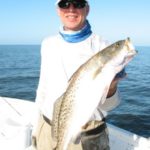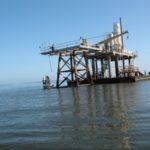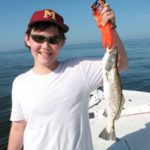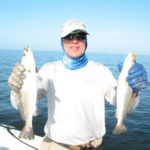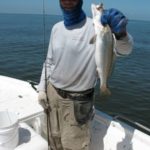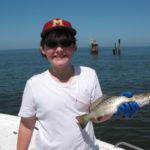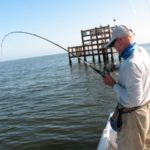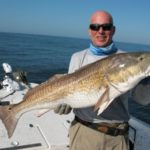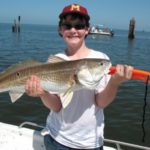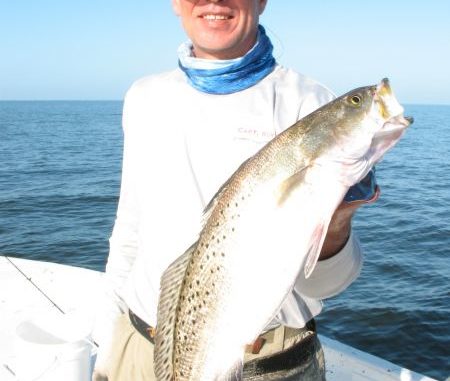
The heat is on this month, but trout are still swimming in Breton Sound just waiting to be fed. Here’s what to use and how to find them during the dog days of summer.
The urban dictionary of slang defines a “beat-down” as when you pummel or repeatedly beat something (or someone) into submission.
And that’s exactly what you might have to do to catch fish in August.
Everyone who fishes the coast knows the challenges August rings. It’s hot. As in sweltering, humid, clothes-sticking–to-your-back-after–five-minutes-outdoors hot.
Average high temperature this month is a 91 sweltering degrees, which vies with July every year for being the hottest average temperature.
August also competes with July for the second-highest average monthly rainfall (June takes first place), and it’s the second-most-active month for tropical activity (September takes the blue ribbon in that category, followed by August and October).
August also runs neck and neck with July for the highest average water temperatures along the coast, which presents another set of challenges.
Either you leave the dock exceptionally early — as in dark early — to get on the very early trout bite (generally the best feeding period of the hot summer months, unless it’s the morning after the full moon) or you can avoid the hottest part of the day and make a late-afternoon trip.
The 5 to 8 p.m. window can be productive, but whether you leave early or fish late, either option might require you to do some running in the dark.
Also, the fish often go deeper this month to find cooler water, so that means you might have to run farther to find them.
But what is a little challenge to us dyed-in-the-wool fishermen?
I made a call to Capt. Rory Rorison of United Charters (504-439-1680) to see if he’d be willing to rise to the August challenge and take me out for a Breton Sound beat-down. Not only did he agree, but Rorison allowed me to take my 12-year-old grandson, Caleb Giraud, along for what we hoped would be a massacre.
Rorison runs his charter business out of Shell Beach, and after loading up the bait well of his 24-foot Blazer Bay Boat with live shrimp and live croakers from Campo’s Marina, a 250-horsepower Suzuki pushed us straight for Breton Sound.
Depending on your fishing strategy for the day, you have two options as to what route you take out of either Shell Beach or Hopedale.
If the rocks along the end of the MRGO are on your early morning agenda, the quickest route is to run the Spoil Canal almost directly across the bayou from Hopedale’s Breton Sound Marina. There are some twists and turns along the route and a shallow spot or two, but the 13-mile run will deliver you to the beginning of the two jetties and have you fishing in no time.
You also have the Dope Boat option (about four miles past the end of the long rocks), and some scattered rigs and structures nearby.
But if your strategy is to fish Bay Eloi and points beyond, such as Breton Sound, a better route might be the Bayou Loutre/Half Moon/China Pass into Lake Eloi and Bay Eloi route. If you’re unfamiliar with the route, plan it out on your map or GPS before you leave, or invest in one of Standard Mappings E-Cards of the area. The E-Cards put the color Standard Aerial map right into your Lowrance GPS so you can’t get lost, and the route is preloaded into the card. If you haven’t seen this yet, you owe it to yourself to check it out.
The reports were that anglers were catching some trout in Bay Eloi and along the MRGO Rocks, all of which are good spots in the summer months and through September. But Rory said the trout in both areas were pretty small.
“There’s plenty of legal-sized fish in Eloi right now, but a 14- or 15-inch trout out there would be a whopper,” he said. “I’m hunting some bigger fish today.”
That meant we’d take the latter route and head out into the Sound for deeper water and bigger fish. But Rorison’s strategy was to first make a stop at Point Chicot to see if it held some hefty trout.
Standard Map No. 304 of Shell Beach has Old Chicot Island at waypoint 29 43.92 x 89 15.72, about five miles east of Deadman Island. Old Chicot Island is now just an underwater reef, but our target wasn’t the old island — instead, we headed to a spot about ¼-mile before the reef, where a single set of pilings jut out in open water like a solitary sentinel, marking a spot that once was a larger rig and a nearby satellite structure.
That single set of pilings is all you see above the surface. Underwater, however, it’s a different story.
“The bottom here is all rocks and shells, the remnants of the large structure that was once here,” Rorison said as he idled toward to solitary set of pilings. “Over time, all of those rocks developed into an entire aquatic community of underwater species, and it has produced some very nice trout this year. It’s been pretty consistent until late June and July. The action became sporadic, kind of hit-and-miss, boom or bust. Then we had a little uptick in action here for about a week, and now it’s just unpredictable.
“But it’s always worth a try.”
On the few occasions I’ve fished that spot, I either had to put my anchor over and position my boat to fall back toward the structure or I’d rig-hook onto the pilings if there were no other boats around.
On a trip just a couple weeks before, I pulled up to this exact spot to find seven other boats already there, all anchored up and fishing — and two more boats were on the way. On that trip I sat and watched as one boat seemed to be into the prime action and everybody else pretty much watched those anglers catch fish.
I probably sat out there for 20 minutes watching that boat land fish after fish while we couldn’t get a nibble.
If that’s not frustrating enough, you have to consider that this spot is in wide-open water, far from any land and pretty far from any other structure. So you have to decide beforehand whether you want to roll the dice and hope you don’t waste the early morning and the prime fishing time on a boom-or-bust proposition.
Rorison has one of those fancy Minn-Kota i-Pilot trolling motors, so he didn’t have to anchor or use a rig hook. He just dropped the trolling motor over and positioned the boat where he wanted it to be and pressed the “anchor” button on the trolling motor remote, and the internal GPS mechanism kept the boat right there. It sped up and slowed down automatically to keep us in that spot. Fannnncy.
Despite the fact that we had the structure all to ourselves on this day, the fish weren’t there. And we tried fishing it in a variety of ways.
We put out live shrimp and live croakers on the bottom, under a sliding cork and under a popping cork. When that didn’t work we made a circle all around the pilings, knowing something had to be down there to eat our bait.
It was, but only ladyfish and catfish, and a single sheepshead.
After about 30 minutes, Rorison had had enough, and we picked up and headed out toward Little Central.
“Little Central is what we call the area roughly between the large Block 18 rig just off the northeast side of the MRGO, all the way to the Compressor Rig on the opposite side and all the smaller satellite structures in between,” he said. “It’s a big area, and it holds fish.”
Rorison skipped past the No. 18 rig and chose instead to i-park the boat (via the i-Pilot) near a smaller satellite rig where he said he’d caught some trout a couple of days before.
The water in this area is about 15 feet deep, but near structure it can rise to about 12 feet due to the thick shell pads surrounding them. We put live shrimp on Carolina rigs and sent them to the bottom to do their job.
In less than a minute we had multiple hookups, but from the arch in the rods and the peel of the drags we knew these weren’t specks but big bull reds.
My grandson, Caleb, had the fight of his life on the end of his line, and the look of shock on his face revealed his amazement that a redfish could fight so fiercely.
After staging run after run, the big reds finally wore themselves out and succumbed to the landing net. Once aboard, they were photo’d and released to battle another day.
Rorison laughed and said that was not what we were looking for, but the elation in Caleb’s face more than made up for any disappointment. We dropped our lines over again and met immediately with the same result — big bull reds.
While we sat there and battled redfish, I could hear a crackle of voices talking over the marine radio. It was the voice of several charter guides, querying one another on their success.
The gist of the conversation between the three or four guides was that the trout were playing hard to get that morning, and most were picking off only a few stragglers here and there.
One guide reported a pretty good catch of school-sized trout at a rig in Bay Eloi, and he invited the others over if their spots didn’t pay off.
Rorison seemed unconcerned by the lack of trout in our boat, and he basically ignored the chatter from the radio except for when they asked him how he was doing.
His reply was short and to-the-point.
“No trout in the boat; we’re playing catch and release with bull reds right now,” he said into the microphone.
“Roger that,” the voice replied. “Come join us at the Lights if you want to catch some trout,” it said.
You see, some of the charter guides have developed a pretty good system for finding fish. Not only are they accomplished fishermen, but they’re on the water day after day, finding the fish and seeing their patterns.
And they also have a network of others they communicate with on the water. A solitary boat out on water you haven’t fished in weeks or months, trying to find a concentration of fish can be like shooting in the dark, hoping you bag a 12-point buck.
So these guides have a network on the water, covering a wide swath of area, each an accomplished guide, each knowing the hotspots, and each willing to communicate that to the others.
So what stops the non-guides from eavesdropping on their conversation and making a bee-line to their hotspots?
Codes. They don’t call anything by the names you’d recognize.
The “Lights” was no doubt a rig with lights around it, and there were other code names for rigs and spots they knew amongst themselves.
I didn’t pry any further into the code names with Rorison because these guys are making a living in a tough business, and the fact that they cooperate for everybody’s success is admirable.
Besides, when I go in my boat I want to find my own fish. I’ll ask where the fish are biting and follow advice from reliable sources, but I don’t want to intrude into another angler’s spot, and “fish in their boat.”
Which brings up our next stop.
We played catch and release with bull reds until our arms, backs and shoulders were sore. Caleb was laid out flat bow of the boat, exhausted.
“Best fishing trip, ever!” he said.
Besides more big reds than we counted (some in the 20- to 25-pound class), we caught numerous sheepshead, gafftops, ladyfish and a 5 foot blacktip shark that put on an almost tarpon-like aerial display before it severed my line.
The morning had worn down and the chatter on the radio revealed that most of the guides were still struggling to find trout. One lone voice invited the others to join in at the sole bright spot in Bay Eloi.
Rorison ignored the chatter and pointed the bow to a well-known hotspot on the fringe of Little Central, the Compressor Rig.
“Another good area out here is the Five Wells, which is basically the big Block No. 32 rig, a nearby cement rig and a bunch of smaller satellites,” he said. “I fish there either on the bottom or 3 to 4 feet under a cork. You can catch fish both ways.
“Just remember to fish all sides of a rig because the fish will often concentrate on one section or corner. You can strike out on one corner and hit the bonanza on the opposite corner, so move around until you find them.”
I was surprised that only one boat was parked at the Compressor Rig, and they were hooked on a corner and casting over the set of flow pipes at what is considered the best spot on the rig. And as we slowly approached I could see them reeling in a nice trout.
Rorison i-parked the boat a respectable distance well out of range of the other boat, and we cast our baits toward the series of pilings on the nearby end of the rig.
We immediately caught a very nice trout in the 2-pound range, followed by over 50 more.
They didn’t all come in a crazed fury of feeding frenzy, but they came in steadily. And they readily ate up both the live croakers and shrimp.
But what they didn’t hit — or at least not after we started fishing — was the other boater’s baits.
You see, they were fishing with plastic, and they were catching fish until we showed up with live bait and took all the action away. We weren’t in each other’s way but we were clearly visible to each other, but once we put our live bait in the water I never saw them catch another fish.
Lesson learned: Bring live bait.
You can probably catch some fish on plastics, but without live bait aboard you are at a big disadvantage if another boat comes along with it.
This was further illustrated by the following incident.
As we fished, steadily catching very nice trout, another boat approached, saw us in the action and drove right over the spot where we were casting.
I was dumbfounded.
“Do you see this often out here?” I asked.
He just shook his head in disgust.
“It’s sheer ignorance,” he said. “I see these guys pull up with a brand-new $100,000 dollar boat, and they don’t have the first clue on how to handle it.”
The fishermen in the boat then hooked onto the piling where we were casting and started to throw right on top of our lines.
It was all we could do to keep our composure.
Soon we were tangling lines with the other boat, and it finally dawned on the captain that he might be parked too close to us.
Interestingly, they too, came armed with only plastic, and despite their fishing in the exact same spot we fished all they could do was watch as we continued to put a beat-down on the specks.
After a while, we’d had enough. My grandson and I were sunburned, sore-armed and battle weary, and ready to call it a day. Incredibly, we had to force ourselves to leave because the trout were still biting.
It was a Breton Sound beat-down, and this time we did the beating.
